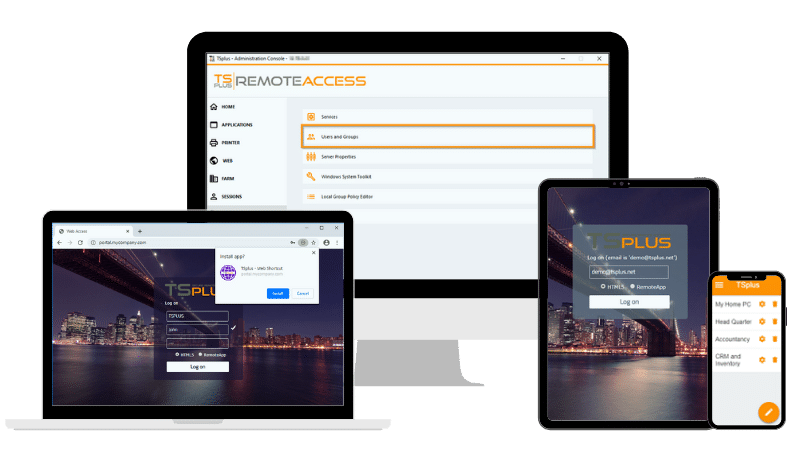)
)
Monitoring Windows services is essential to ensure the reliability, performance and security of your IT environment. Command lines, Powershell, scripting… all those could mark the “build your own” path. Yet, when time is scarce, a simple efficient software tool out-of-the-box could be more welcome than a precise tutorial or a new set of skills. In this guide, we explain what Windows services are, why monitoring them matters, and how to do it effectively, whether manually or with automated tools such as TSplus Server Monitoring.
What Are Windows Services?
Windows Services are core background processes that operate independently of user sessions. They are responsible for essential functions such as:
- Managing network connections
- Running print jobs
- Supporting antivirus protection
- Logging events and errors
- Handling DNS caching and resolution
Unlike traditional applications that are launched manually by users, Windows services typically start automatically during system boot and continue to run in the background. They often have special privileges and generally ensure the system operates smoothly.
Examples of Common Windows Services:
| Service Name | Function |
|---|---|
| Spooler | Manages print jobs |
| W32Time | Maintains date and time synchronization |
| Windows Update | Automates patch downloads and installations |
| DNS Client | Resolves domain names |
| Security Center | Monitors system security settings |
Should you want to see those running on your device, one of the easiest paths is to search “services” in the Windows menu search bar.
To view services on a Windows machine:
- Press
Windows + R, typeservices.msc, and press Enter. - Use the list to see service names, status and startup type.
With admin rights, you can also stop a service or choose when to run it: whether at start-up or later, automatically or manually. Although, please bear in mind, first ensure whether the change will interfere with proper running of anything crucial.
3- Right-click a service to start, stop or configure it.
Why Is Monitoring Windows Services Important?
Monitoring services ensures that mission-critical operations remain uninterrupted. They usually run in the background before any sessions are initiated and are therefore shared by all, hence why services often affect users so widely however invisible they remain. Indeed, a stopped service can quickly escalate into system downtime, productivity loss or security vulnerabilities.
Here are key reasons to monitor Windows services:
- Uptime assurance - Prevents unnoticed service failures.
- Security compliance - Ensures firewalls, antivirus or update services stay active.
- Performance optimization - Identifies resource-hogging or misbehaving services.
- Proactive maintenance - Detects anomalies before they become problems.
Regularly checking service health is essential for maintaining enterprise-level reliability and fault tolerance.
What Are the Key Questions to Consider Before Monitoring?
Before implementing any monitoring solution for Windows services, it is important to define your objectives and technical requirements. Asking the right questions up front will help you choose the most effective approach (manual scripting, a built-in method or a dedicated monitoring tool).
1. Which Services Are Mission-critical?
Identify services supporting essential business operations or system integrity, such as backup tools, security software, remote access service, etc. Prioritizing these ensures the most vital parts of your infrastructure remain protected.
2. Do You Need Real-time Alerts?
If service interruptions need immediate attention, manual checks are insufficient. A solution with real-time alerting via email or dashboard notifications becomes essential to respond promptly and prevent downtime.
3. How Many Systems Are Involved?
Monitoring a single machine is manageable manually, but as soon as you scale to multiple servers or endpoints, manual methods become inefficient and error-prone. For multi-device environments, a centralized system is more appropriate.
4. Who Should Receive Which Monitoring Reports?
Determine who needs access to monitoring data: IT administrators, compliance officers, business stakeholders…. Also weigh up which data each requires. Assigning roles and responsibilities ensures alerts are actionable and reports reach the right people.
5. Is Trend Analysis Necessary?
If long-term visibility into system behavior is important, you need a monitoring tool which logs and visualizes historical data. This helps identify patterns, plan maintenance and anticipate future issues before they escalate.
In Which Case Do You Choose a Monitoring Tool?
Using a software-based monitoring solution becomes all the more valuable when your infrastructure or business needs exceed the limitations of manual methods. These tools streamline service tracking, provide advanced features and reduce the technical burden on your team.
A monitoring tool is the right choice if you:
- Manage multiple servers or endpoints - At scale, manual monitoring becomes unmanageable. A centralized platform allows you to oversee all systems from one interface, improving efficiency and consistency.
- Need to report performance over time - Built-in logging and analytics help track trends, visualize uptime and identify recurring service issues, additionally covering data compiling.
- Must meet compliance or SLA obligations - Automatically generated, time-stamped reports lets you produce required evidence for audits or contractual reviews.
- Want alerts without writing custom scripts - Monitoring software comes with built-in alert systems, so you can receive email or dashboard notifications instantly, no scripting expertise required.
- Require non-technical staff to operate the tool - User-friendly dashboards and intuitive navigation enables support teams, managers or compliance officers to access service data without deep technical training.
What Are the Challenges of Manual Monitoring?
Regular manual monitoring of Windows services (whether through Task Manager, command-line tools or PowerShell scripts) can be effective for isolated machines or small networks. However, as your infrastructure grows or compliance requirements increase, this approach quickly becomes inefficient and risky.
Common Limitations:
- No centralized view - You can only monitor one machine at a time, making it difficult to maintain visibility across multiple servers or environments. This slows response times and increases the risk of missing critical failures.
- High learning curve - Effective scripting in PowerShell or CMD requires technical expertise. Even small changes or errors in a script can lead to incorrect monitoring or unintended system issues.
- No built-in alerting or analytics - Manual setups lack real-time alerts or built-in dashboards. You will need to develop and maintain custom scripts just to receive notifications or analyze service performance.
- No audit trails - Without automated logging, it's difficult to track service behavior over time or generate documentation (logs, reports, …) for audits. This can pose challenges for security, compliance and incident resolution.
What Are the Manual Methods to Monitor Windows Services?
If you manage a small environment or prefer hands-on control, Windows offers several built-in options for monitoring services. Below are the most common methods.
- Task Manager
- PowerShell
- Command Prompt (SC Utility)
Task Manager
The Services tab in Task Manager provides a simple interface to start or stop services manually. You can also view dependencies by right-clicking a service and selecting "Go to Details".
Limitations:
- No alert system
- No historical data or trend monitoring
- Not suitable for multiple machines
PowerShell
PowerShell is a versatile tool that can monitor services, restart them and even generate logs or alerts.
Basic script to check service status:
Get-Service -Name 'wuauserv' | Select-Object Name, Status
Monitor multiple services:
$services = "Spooler", "wuauserv", "Dnscache"
foreach ($svc in $services) {
Get-Service -Name $svc | Select-Object Name, Status
}You can also create scheduled tasks to run these scripts regularly and send email notifications if a service is not running.
Pros:
- Full automation capability
- Fine-grained control
- Works on remote machines
Cons:
- Requires scripting skills
- Time-intensive to maintain
- Lacks graphical reporting
Command Prompt (SC Utility)
The SC (Service Controller) tool is a command-line utility that allows querying, starting and stopping services.
Example:
sc query wuauserv
SC provides raw output, which is helpful for scripting but not user-friendly for regular monitoring.
How to Use TSplus Server Monitoring to Track Windows Services?
For organizations seeking simple efficiency, TSplus Server Monitoring provides a streamlined and user-friendly solution. It removes the technical hurdles of manual monitoring and offers a centralized dashboard for overseeing all services across all servers.
Key Features:
- Automatic detection of services and processes
- Real-time monitoring of service status
- Custom alerts when a service stops or consumes excessive resources
- PDF reporting for compliance or performance reviews
- Historical logs for trend analysis
Centralized visibility is key to operational efficiency and proactive IT management.
The “Process Usage” Panel
For example, Server Monitoring provides a Process Usage section, giving real-time insights into:
| Metric | Description |
|---|---|
| Service Name | Identifies the Windows Service |
| Username | Indicates the user context |
| Memory Usage | Highlights memory-heavy services |
| CPU Usage | Detects performance bottlenecks |
| Network Usage | Shows bytes sent/received per process |
This level of detail is ideal for detecting rogue or malfunctioning services that silently consume resources or crash systems.
What Are the Security & Compliance Advantages of Using TSplus Server Monitoring?
Using a structured monitoring solution like Server Monitoring significantly enhances your IT environment’s security, stability and regulatory compliance. Beyond gaining time or service visibility, it provides the tools and documentation necessary to proactively manage risks and meet industry standards.
Key Benefits:
- Prevents critical services from staying down unnoticed
Real-time alerts and automatic status checks ensure that vital services like antivirus, firewall or backups are continuously monitored. Being alerted on these minimizes exposure to threats and helps prevent service outages from affecting operations. - Helps maintain SLAs and internal KPIs
TSplus allows you to track service uptime and system performance against predefined targets. By automating, monitoring and reporting, teams can respond faster and stay aligned with service-level commitments. - Supports GDPR, HIPAA or other compliance requirements
With timestamped logs, historical records and audit-ready PDF reports, Server Monitoring helps document service availability network-wide, enhancing issue resolution, which is essential for passing audits and demonstrating accountability under data protection laws and IT governance standards.
This combination of security assurance, operational visibility and compliance readiness makes this TSplus tool a powerful ally in modern IT management.
Conclusion
Monitoring Windows services is a critical part of maintaining IT infrastructure. While manual tools like PowerShell and Command Prompt offer granular control, they come with complexity and scalability issues. Automated solutions like TSplus Server Monitoring provide a more efficient, scalable and user-friendly alternative. With real-time insights, automated alerts and centralized management, you can ensure that your systems are always operating at peak performance. Whether you are responsible for a single server or a global IT environment, reliable monitoring helps you stay ahead of problems before they affect users or business operations.

TSplus Remote Access Free Trial
Ultimate Citrix/RDS alternative for desktop/app access. Secure, cost-effective, on-premises/cloud














)
)
)